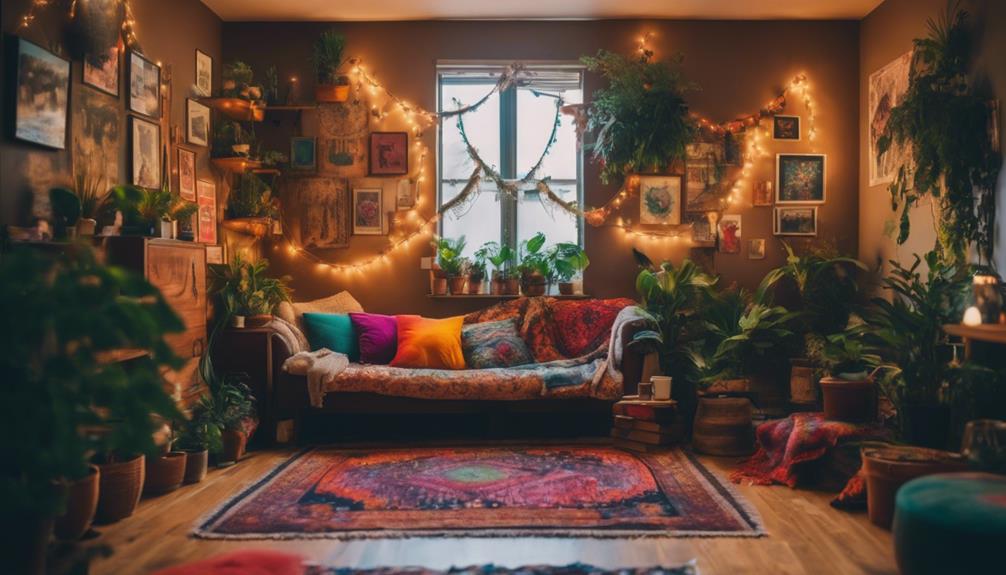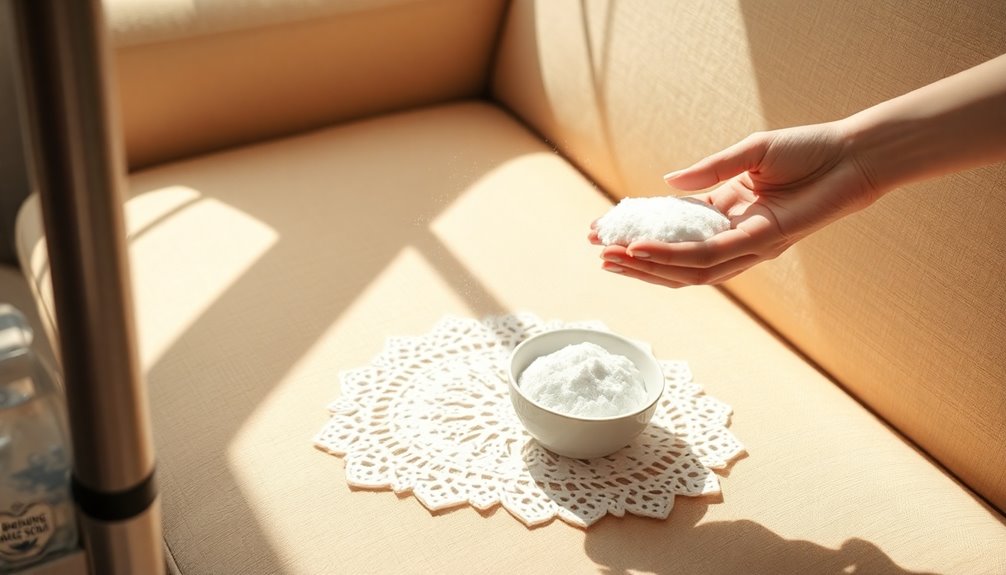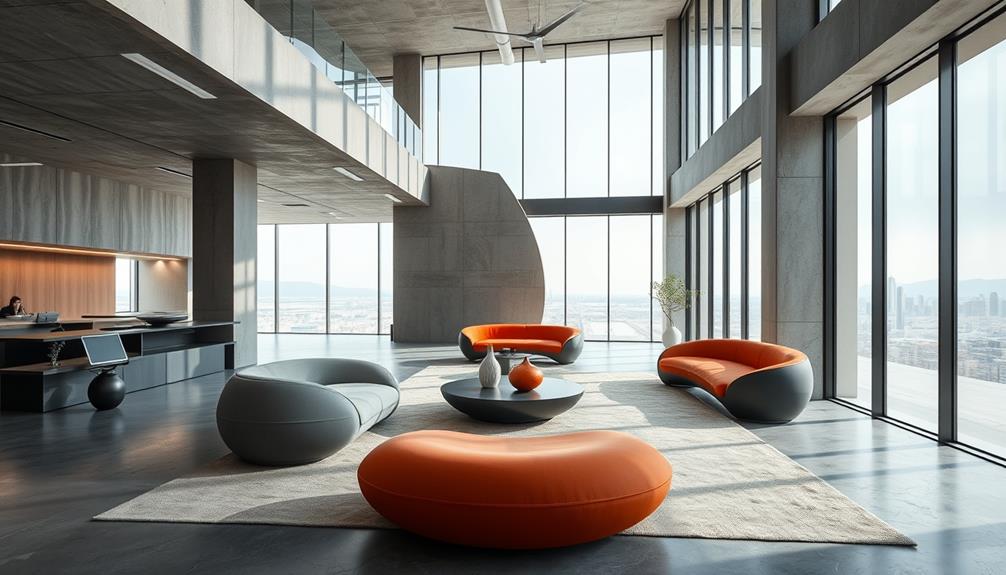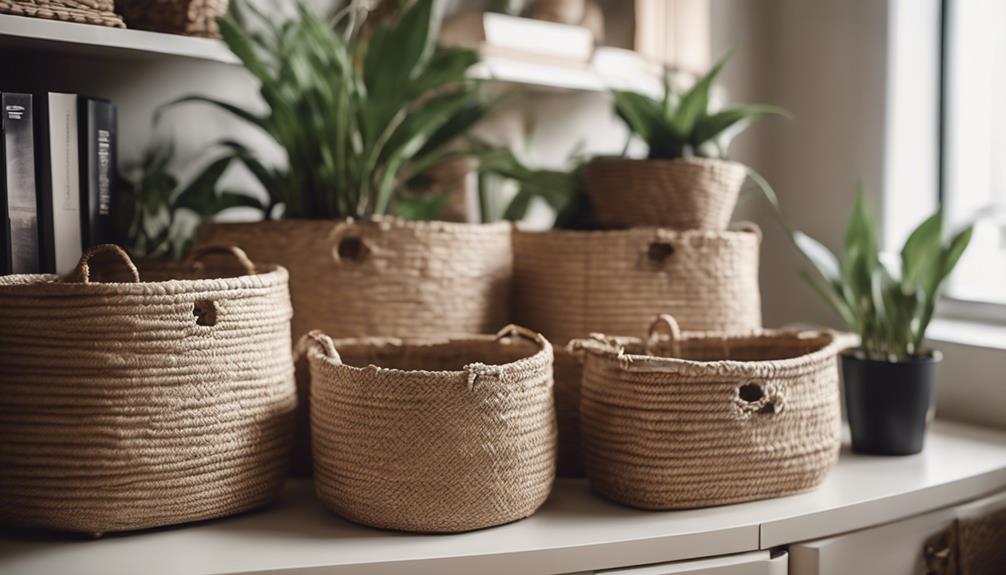Aesthetic stationery has the power to turn your workspace into a chic sanctuary that sparks creativity and increases productivity. Opt for a coordinated color palette with calming neutrals and bright accent shades that mirror your unique style. Invest in top-notch supplies such as silky gel pens and textured notebooks to enrich your writing experience. Integrate ergonomic furniture and cozy lighting to establish a welcoming environment, while decorative items like botanical art prints bring a refreshing touch. By making smart selections, you can not only beautify your space but also enhance your daily routines. Explore additional tips on how to take your workspace to the next level!
Key Elements

When you think about aesthetic stationery, consider the color scheme, materials, and textures that resonate with your personal style.
Choosing the right colors can set the mood, while high-quality materials and intriguing textures elevate the overall experience.
Let's explore how these key elements can transform your workspace into a creative haven.
Color Scheme
A cohesive color scheme not only enhances your workspace's aesthetic appeal but also inspires productivity and creativity. By strategically choosing a color palette, you can create an environment that feels both organized and inviting.
Start with neutral colors for your writing tools, like Mildliner highlighters and pens, to establish a calming foundation that promotes focus and minimizes visual clutter.
Next, think about incorporating accent colors through your stationery items—colored pens, notebooks, or even decorative clips. These pops of color add personality and flair without overwhelming the overall design.
To further unify your space, customize your digital wallpapers to complement your physical stationery. This harmonious look ties together both your digital and physical areas, enhancing the overall aesthetic.
Consistency is key; using a specific color palette across all your stationery and decor reinforces your personal style, creating a cohesive and inspiring workspace.
By carefully selecting your colors, you not only elevate the visual appeal of your area but also foster an environment that encourages creativity and productivity.
Materials
High-quality materials are essential for creating an aesthetic stationery collection that enhances both your writing experience and workspace appeal. When you invest in smooth gel pens and premium notebooks, you're not just keeping things functional; you're elevating your entire desk setup.
Items like Mildliner double-ended highlighters in neutral tones add a touch of sophistication while proving useful for tasks like book annotation.
Versatile tools, such as Lamie ballpoint pens and Sharpie S-Gel pens, provide reliability and style, ensuring that your workspace looks as good as it feels. Customizable elements, including personalized planners and unique washi tapes, allow for creative expression. They can transform mundane tasks into visually pleasing activities that inspire you daily.
To complete your aesthetic, consider organizing your stationery in decorative containers or stylish desk organizers. This not only keeps things tidy but also serves as an aesthetic focal point, making your workspace inviting.
Textures
Incorporating various textures, from smooth to matte and glossy finishes, instantly adds visual interest and elevates your stationery's aesthetic. Textured paper, like linen or felt, transforms your writing experience, giving your notes a tactile quality that enhances their impact. When you choose textured stationery items—such as embossed notecards or patterned journals—you not only showcase your personal style but also maintain functionality.
You can further enrich your workspace by adding textured elements like washi tape or fabric-covered binders, introducing dimension and warmth to an otherwise flat environment. This small touch can make a big difference in how your workspace feels and looks.
Experimenting with a mix of materials—like metal, wood, and fabric—creates a harmonious yet dynamic atmosphere that inspires creativity. Each texture interacts with light and shadow, drawing the eye and encouraging a sense of curiosity.
Essential Fixtures and Furniture
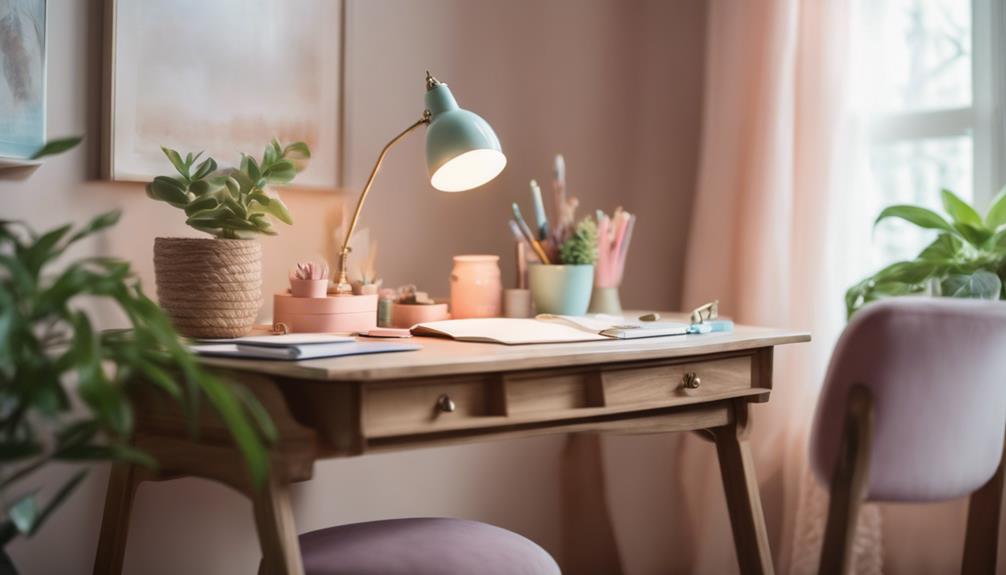
When setting up your workspace, choosing an ergonomic desk with storage is vital for both comfort and organization.
Pair it with a stylish bookshelf that features a curved design to add visual interest, and don't forget a vintage-inspired desk organizer to keep your essentials handy.
These fixtures not only enhance functionality but also elevate the overall aesthetic of your space.
Ergonomic Desk With Storage
An ergonomic desk with storage not only promotes better posture through adjustable height features but also keeps your workspace organized with built-in drawers and shelves. You can easily alternate between sitting and standing, reducing physical strain during those long hours at your desk. By incorporating storage solutions like drawers, you'll minimize clutter, making it easier to find frequently used items.
Consider adding a laptop stand to elevate your screen to eye level. This adjustment improves ergonomics and encourages a more comfortable working posture, alleviating neck and shoulder tension. An integrated cable management system can also help keep cords organized and out of sight, contributing to a tidy workspace that looks great.
To further enhance the functionality of your desk, think about using accessories like file sorters or desk organizers. These tools optimize your available surface area and guarantee your essential items are easily accessible. By combining style with practicality, you'll create an efficient and aesthetically pleasing work environment.
With the right ergonomic desk and storage solutions, you can transform your workspace into a haven of productivity and style, impressing everyone who walks in.
Stylish Bookshelf With Curved Design
A stylish bookshelf with a curved design not only elevates your workspace's aesthetic but also maximizes organization by providing a unique way to display books and decor.
The flowing lines of a curved bookshelf create a sense of movement, enhancing the overall look of your room. This design choice is particularly appealing in modern and minimalist interiors, where simplicity meets style.
Curved bookshelves come in various materials, such as wood, metal, or acrylic, allowing you to customize them to match your personal taste. This versatility means you can easily integrate the bookshelf into your existing workspace theme.
Plus, the ergonomic design promotes accessibility, making it a breeze to reach for your favorite books or decorative items without creating clutter.
Incorporating a curved bookshelf into your workspace can serve as a stunning statement piece. It not only draws attention but also showcases your collection in an organized manner.
Ultimately, a stylish curved bookshelf enhances your environment, offering both functionality and aesthetic appeal, helping you impress anyone who visits your workspace.
Vintage-inspired Desk Organizer
Looking to enhance your workspace's charm? Consider a vintage-inspired desk organizer that blends functionality with timeless style. Available in materials like wood, metal, and leather, these organizers not only serve a practical purpose but also elevate your decor.
With various compartments and drawers, a vintage desk organizer allows you to store stationery, notebooks, and other essentials efficiently. This helps you maintain a clutter-free environment, making it easier to focus on your tasks. The unique design elements, such as ornate detailing or distressed finishes, bring character and personality to your workspace, setting it apart from conventional setups.
Incorporating a vintage desk organizer can also spark conversations, impressing colleagues and clients alike with its nostalgic appeal and thoughtful craftsmanship. Beyond organization, it creates a visually pleasing workspace that encourages creativity and productivity.
Lighting Ideas
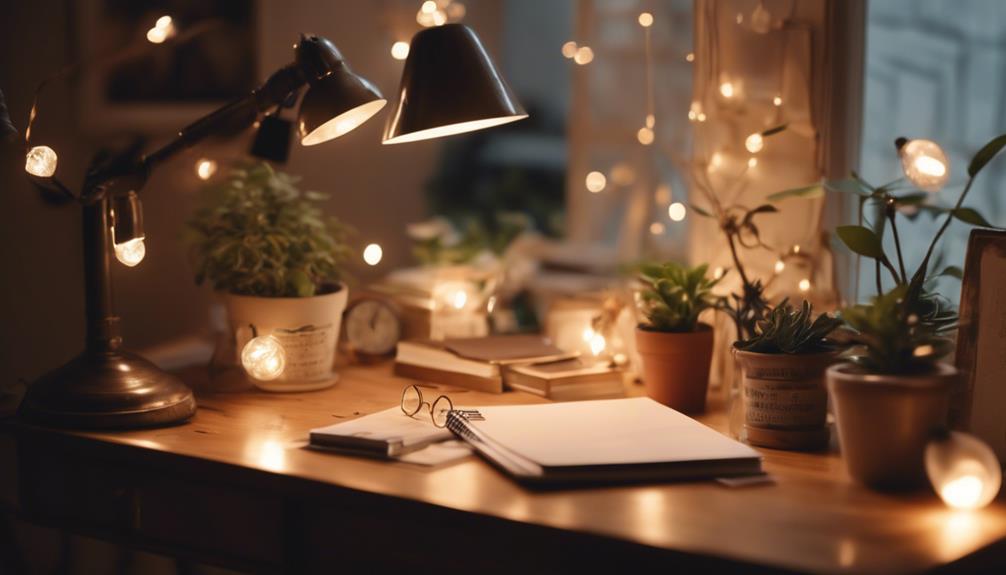
When it comes to lighting, choosing the right fixtures can transform your workspace.
Consider warm LED pendant lights for a cozy feel, or opt for sculptural and geometric designs that add a modern touch.
Don't forget about maximizing natural light with stylish window treatments to enhance your overall aesthetic.
Warm LED Pendant Lights
Warm LED pendant lights transform your workspace into a cozy haven, boosting both comfort and productivity. Unlike harsher lighting options, these lights reduce eye strain, allowing you to work longer without discomfort.
With energy efficiency in mind, they consume up to 80% less energy than traditional incandescent bulbs, which means you'll save considerably on electricity bills over time.
These pendant lights come in a variety of designs and styles, making them perfect decorative focal points that effortlessly blend aesthetics with functionality. The warm color temperature, typically ranging from 2700K to 3000K, offers a soft glow that mimics natural sunlight, improving your mood and focus during those long working hours.
Additionally, many warm LED pendant lights feature adjustable brightness settings, so you can customize the illumination level to suit your specific tasks and preferences. This flexibility enhances the versatility of your workspace lighting, ensuring you always have the right amount of light for what you need.
Sculptural Table Lamp Design
Sculptural table lamps elevate your workspace by merging form and function, transforming ordinary lighting into striking artistic statements. These lamps serve not just as sources of light, but also as unique decor that enhances the aesthetic appeal of your desk or side table. With their innovative shapes and materials—like metal, glass, or ceramic—they become focal points that reflect your personal style.
Many modern sculptural table lamps come with adjustable features, allowing you to direct light exactly where you need it. This promotes better ergonomics and helps reduce eye strain during those long working hours. Plus, energy-efficient LED bulbs are commonly used, offering eco-friendly lighting solutions and extending the lifespan of the fixture.
The right table lamp can dramatically influence the mood of your workspace. Warm light creates a cozy atmosphere, making it perfect for relaxation, while cool light enhances focus and productivity. By choosing a sculptural table lamp that resonates with your aesthetic, you're not just lighting your space; you're curating an environment that inspires creativity and efficiency.
Geometric Floor Lamp Design
Geometric floor lamps bring a contemporary edge to your workspace with their striking lines and bold shapes. These lamps often feature clean lines and angular designs, making them a favorite for modern and minimalist aesthetics. When you incorporate a geometric floor lamp, you're not just adding light; you're also introducing a piece of art that enhances your overall workspace vibe.
Many of these lamps use materials like metal, glass, and wood, offering various textures and finishes that can complement your existing decor. If you value flexibility, look for adjustable models that allow you to customize height and light direction. This adaptability not only boosts functionality but also adds a stylish touch to your setup.
Energy-efficient LED bulbs are commonly used in geometric floor lamps, providing bright illumination while helping you save on electricity. Plus, the longevity of these bulbs means you won't have to replace them frequently.
The striking geometric patterns can serve as a focal point, creating visual interest and enhancing the ambiance of your workspace. So, consider a geometric floor lamp to elevate your environment while keeping it stylish and functional.
Natural Light Maximizing Window Treatments
Maximizing natural light in your workspace can greatly boost your mood and productivity, making the right window treatments essential. Choosing sheer or light-filtering options is a smart way to increase brightness while minimizing glare. This creates a more inviting atmosphere that keeps you energized throughout the day.
Roller shades or Roman shades in light colors not only elevate your workspace's aesthetic but also offer adjustable light control, allowing you to adapt to changing daylight. Reflective surfaces, like light-colored curtains or blinds, can bounce natural light around, making your space feel larger and more open.
Breathable materials such as linen or cotton are excellent choices for window treatments, as they promote better air circulation, keeping your environment comfortable during long hours of work. Additionally, consider options with adjustable features, like vertical blinds or slatted designs, which let you customize the light entering your workspace according to your needs.
Decorative Elements
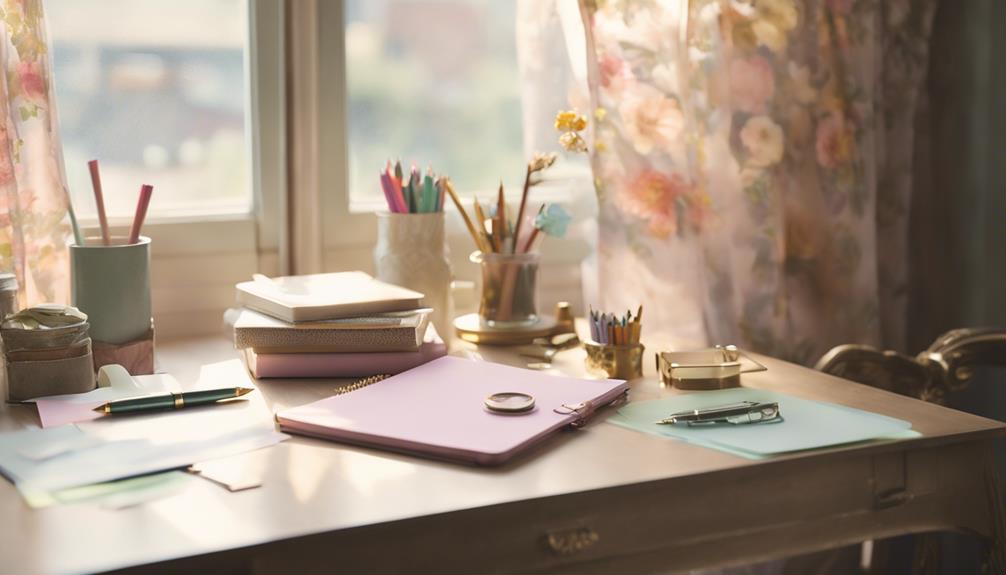
When it comes to enhancing your workspace, decorative elements play an essential role.
Framed botanical art prints, handcrafted ceramic vases, and colorful abstract wall tapestries can transform your environment into a more inspiring place.
Framed Botanical Art Print
Adding framed botanical art prints to your workspace instantly brings a revitalizing touch of nature and tranquility. These art pieces not only enhance the aesthetics of your area but also uplift your mood. If you choose prints with vibrant colors, they can energize your workspace, while softer tones create a calming atmosphere that's perfect for focus and creativity.
Incorporating botanical art into your decor helps you connect with nature, which can greatly reduce stress and improve your overall well-being. When selecting frames, opt for those that complement your existing decor to create a cohesive look. This thoughtful approach makes your workspace feel more organized and visually appealing.
Don't forget to regularly update your framed botanical prints to keep your environment fresh and inspiring. Changing your artwork can spark new ideas and contribute to a dynamic, engaging work atmosphere.
Handcrafted Ceramic Vase
Incorporating a handcrafted ceramic vase into your workspace not only complements framed botanical art but also adds a unique touch that improves your overall decor. These vases come in various shapes, sizes, and glazes, making them versatile decorative elements that fit seamlessly with any aesthetic. Each piece showcases the artisan's skill and creativity, providing a personal touch that elevates your workspace.
You can use ceramic vases to display fresh or dried flowers, which will enhance the natural ambiance of your desk and create a calming work environment. Adding blooms or even simple branches can breathe life into your space, making it more inviting and inspiring. The durability of ceramic materials guarantees that your vase will withstand daily use while retaining its aesthetic appeal over time.
Plus, having a handcrafted ceramic vase as a focal point can inspire creativity and spark new ideas as you work. It serves not only as a decorative element but also as a reminder of the beauty surrounding you.
Colorful Abstract Wall Tapestry
A colorful abstract wall tapestry can transform your workspace into a vibrant haven, instantly enhancing your aesthetic and sparking inspiration. These tapestries serve as a stunning focal point, drawing the eye and uplifting the overall atmosphere. You can find them in various sizes, making it easy to choose one that fits your wall dimensions perfectly and complements your existing decor.
The blend of colors and patterns in abstract designs can stimulate your creativity and boost your mood, creating a more productive work environment. When you incorporate a tapestry into your space, you're not just adding style; you're also softening acoustics, which makes for a more comfortable atmosphere during those focused work sessions.
Thanks to their lightweight, durable fabric, wall tapestries are a breeze to hang and swap out. This flexibility allows you to refresh your workspace whenever you want, aligning with your evolving style or seasonal preferences.
Flooring
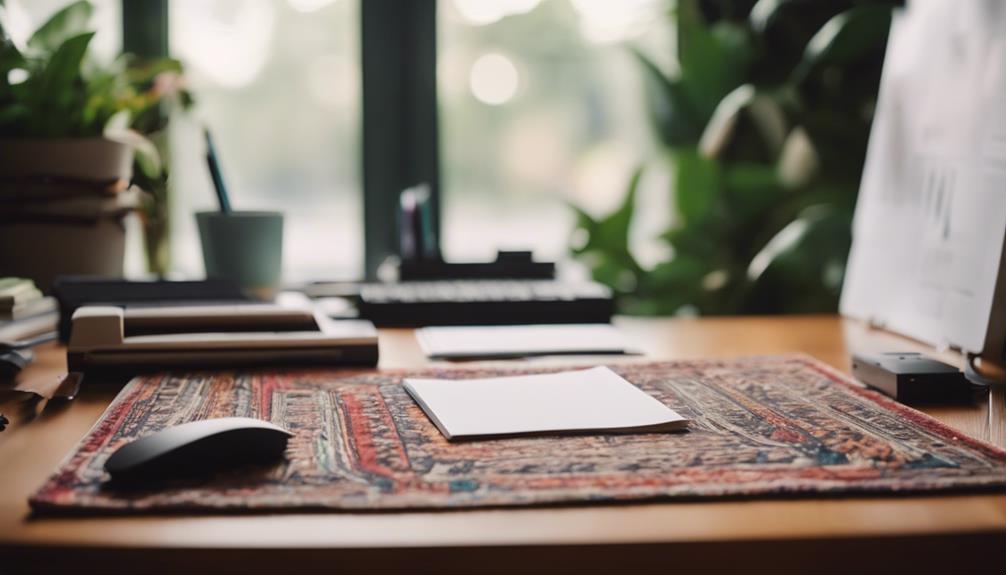
When you think about flooring for your workspace, consider sustainable options like bamboo, which not only looks great but also helps the environment.
Cork flooring offers a comfortable, cushioned feel underfoot, making your space more inviting.
If you're after a rustic charm, reclaimed wood planks can add character while telling a story of their own.
Sustainable Bamboo Flooring Option
Sustainable bamboo flooring offers a stylish and eco-friendly alternative to traditional hardwood, perfect for enhancing your workspace while minimizing environmental impact. Unlike hardwoods that can take decades to regrow, bamboo is a rapidly renewable resource that takes just three to five years to mature. This quick growth makes it a smart choice for those looking to make sustainable decisions.
Durability is another major benefit. Bamboo flooring is often harder than traditional hardwoods, making it ideal for high-traffic areas in your workspace. You won't have to worry about wear and tear as much, allowing you to focus on your tasks.
Additionally, the manufacturing process for bamboo results in lower carbon emissions compared to conventional hardwood flooring, making it an even greener option.
With a variety of styles and finishes available, bamboo flooring can easily complement your workspace design, adding both elegance and functionality. Plus, many products are treated with non-toxic finishes, ensuring a healthier indoor environment free from harmful chemicals.
Cork Flooring for Comfort
Cork flooring brings exceptional comfort to your workspace, thanks to its natural cushioning that absorbs shock and reduces fatigue during long hours of standing or walking.
This eco-friendly option is made from the bark of cork oak trees, making it a sustainable choice for enhancing your environment. You'll appreciate how the unique texture and appearance of cork adds a warm aesthetic to your office, creating an inviting atmosphere while remaining functional.
Additionally, cork is a naturally insulating material, helping to maintain a comfortable temperature in your workspace. This can even lead to reduced energy costs over time, providing both comfort and savings.
If you're concerned about health, you'll be glad to know that cork flooring is resistant to mold and mildew, ensuring a healthier workspace, especially for those with allergies.
Choosing cork flooring isn't just about comfort and style; it's about creating a space that enhances your productivity and well-being. With its blend of functionality and aesthetics, cork flooring makes a fantastic addition to any workspace, allowing you to work in comfort while impressing visitors with your stylish choices.
Reclaimed Wood Plank Flooring
Reclaimed wood plank flooring offers a unique blend of history and character, making it a stylish choice that complements the comfort of your cork flooring. Sourced from old barns, factories, and warehouses, each plank has its own story, adding depth to your workspace. This sustainable option not only reduces waste but also supports environmental conservation by lessening the need for new lumber.
The natural variations in color and grain patterns create a warm and inviting aesthetic, making it a favorite for both rustic and modern designs. When you choose reclaimed wood, you're opting for durability too; the natural aging process often makes it stronger and more stable than new wood.
Moreover, installing reclaimed wood plank flooring can increase your home's resale value. Buyers appreciate eco-friendly practices and high-quality craftsmanship, which makes this flooring a smart investment. By incorporating reclaimed wood into your workspace, you're not just enhancing its style but also fostering a connection to the past.
Conclusion
Incorporating aesthetic stationery into your workspace can transform your environment and inspire creativity.
By carefully selecting essential fixtures, optimizing lighting, and adding decorative elements, you'll create a stylish and inviting atmosphere that captivates everyone who enters.
Don't forget to choose flooring that complements your design, tying everything together beautifully.
So, go ahead and elevate your workspace—your newfound style won't only impress others but also make your day-to-day tasks more enjoyable!

